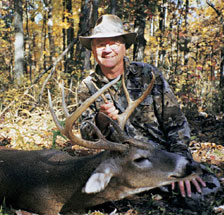Do You Call Deer?
by Dr. Dave Samuel
I first called deer while bowhunting in 1978. My good friend
Len Cardinale had driven in from New Jersey and we were headed for
Canaan Valley in West Virginia to bowhunt. On the drive down,
Len told me how he called deer in by giving a a grunting noise with
the mouth. "Urp." The rules were simple, and they still work
today. If you see a buck and he is not going to come your way,
grunt ("urp") at him. If the buck starts your way, do not call.
If he turns to leave, call.
Len told me that grunting at deer would not scare deer. "They
may not respond, but you will rarely scare them. You have nothing
to lose, so call," Len said. Three hours later, a dandy eight
pointer was walking 100 yards from my stand, so I grunted. He
walked closer, then turned, so I called again. He walked closer,
then started the other direction, so I called, and this time he came.
I shot under him at thirty yards, but it was very windy, so
the buck didn't react. At sixty yards, I called again, and back
he came. This time I didn't miss.
That was the first buck I've talked to, but I've had discussions with
hundreds since that time. I now call almost every time I hunt.
I've expanded my repertoire, and now use other calls. For
example, I often use the Primos "can" doe-in-estrus call to bring
in bucks. Sometimes the calls work, often they don't. It's
hard to know what is going on in a deers psyche that determines whether
they will come in to a doe call. Take the doe-in-estrus "can'
call. Last November, in Alberta, a dandy ten point walked behind
my stand. At sixty yards I called. Nothing. He just
stood there. The wind was in my favor, when I called a second
time. This time he took off like he'd been shot with a gun.
I have no idea why he reacted that way. They usually do
nothing, and once in awhile, they will come in. This guy ran.
The next morning my buddy was in a stand three hundred yards from
that location. That same ten pointer (he ended up weighing in
at 308 pounds, so he was one of those Alberta bruisers) got into a
nasty fight with a larger buck (yes, this second buck weighed more
than 308 pounds). They smashed trees, tore up the brush, and
after three minutes or so, the smaller buck lost the fight. The
winner walked straight away, across an alfalfa field. A few
minutes later my friend used the "can" call and the loser in the fight
came right into to him and that was it. The shot was true, and
we weighed him later that day. Why did he run from that call
the day before? I'll never know. But he responded to my
friends calling even though he'd lost the fight. Maybe his psyche
said.........OK, I hear a doe in estrus calling, and the dominant
buck has left the area, so I'll just go up there and introduce myself.
I've often heard stories about situations where bowhunters should
have tried making a call, either with the mouth or with a grunt call.
For example, the deer is walking and won't stop for a shot.
At full draw, just grunt at him. Not loud. Just
a quiet "urp." Or a deer is just ten yards out of range and
headed away. Just grunt at him. Use your mouth and grunt.
You don't have time to fool with a store-bought call. Grunt.....you
have nothing to lose.
Bottom line, do not be afraid to call. If the deer is walking
a long way off, grunt loud, so he will hear the call. He may
not look at you, but you can usually tell by his body language that
he heard the call. Once, in Michigan, a buck was following
a doe around 100 yards from my stand. I grunted loudly and
I knew he heard it, but he kept following that doe out of sight.
Twenty minutes later, there he was, coming back by himself.
I grunted again and he walked to me and right into my freezer.
Hmmm, maybe there is something to calling deer.

Dr. Dave Samuel is the
Conservation Editor for Bowhunter
Magazine and a frequent contributor to Bowsite.com. |